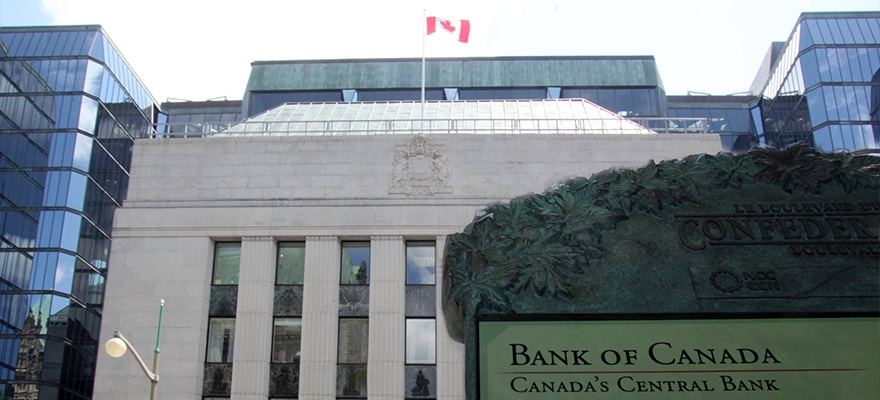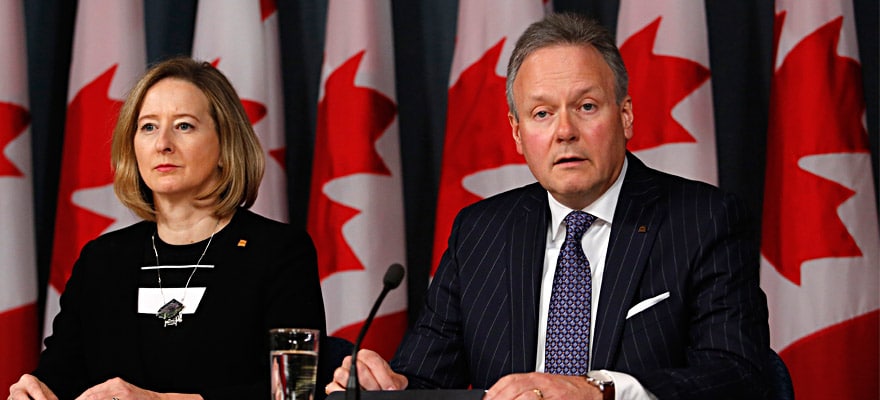The BOC are currently in a wait-and-see mode after unexpectedly cutting rates to 0.75% at the start of this year. Due to Canada's huge reliance on oil exports, the country has seen a marked decrease in growth alongside the depreciation of oil.
The price of a barrel of West Texas Intermediate crude dropped from $108 in June 2014 to a low of $42 in mid-March 2015. The price has since recovered to near $60. During that period, annualized Q/Q GDP fell from 3.8% in Q2 2014 to -0.6% in Q1 2015. The drop in oil export revenue was a large factor in the BOC cutting rates in January, however rates have been left on hold at each meeting since, and there has been no indication of further cuts by the Bank.
Accompanying their most recent rate decision, on May 27, the statement struck a neutral tone stating, "Inflation in Canada continues to track the path outlined in the Bank's April Monetary Policy Report." They recognised that inflation was near the bottom end of the 1-3% range, but this was largely attributed to low energy prices. They noted that core inflation was above 2%.
The statement also said: "Seeing through the various temporary factors, the Bank estimates that the underlying trend of inflation is 1.6 to 1.8 per cent, consistent with persistent slack in the economy." This is close to the 2% mid-point of the target range, which means the Bank is not under great pressure to cut rates again in the immediate future. The Bank saw the economic outlook largely in line with the April Monetary Policy Report, released on April 15.
In the April MPR and rate statement, the BOC projected both total and core inflation to be close to 2% on a sustained basis by the end of 2016, with the economy expected to reach full capacity around that time. They also said risks to inflation are roughly balanced and that that the current level of interest rates remains appropriate for the time being. Nothing has materially changed since these releases.
The most recent jobs report released on June 5, showed the biggest increase in employment in 7 months, buoyed by manufacturing. Alongside it, the unemployment rate remained steady at 6.8%. This provided a rosy picture for the economy, however the jobs numbers have been inconsistent and the prior month showed a drop of 19,700 jobs. We will be looking out for the June jobs numbers to see if there is another positive release, which may indicate the beginning of an upward trend.
On May 29, Statistics Canada released Gross Domestic Product for the first quarter which showed the biggest contraction since the 2009 recession. This was the country's first contraction in four years and was attributed to lower energy prices which caused a decrease in business investment. We also saw a weak Q1 GDP in several other major nations including the USA, which was seen as transitory; a similar case can be made for the weak first quarter in Canada.
Unlike other major currency nations, Canada releases GDP monthly, and the quarterly data is simply a summation of the releases. The next release for growth over the month of April is due June 30. This next release will help confirm or disprove if Canada's contraction is temporary.
The currency itself has been largely tracking sideways in recent months, alongside the price of WTI which has remained around $60 per barrel since the end of April. The dollar-cad pair has pulled of its highs made back in March and has been moving sideways within a 650 pip range for the last 2 months.
There is currently little strong sentiment on the Loonie, and the currency is difficult to trade given its lack of direction. Overall, the fundamentals remain neutral on the Canadian dollar, however there is a greater chance of a cut than a hike in the next 12 months, given depressed commodity prices.

















